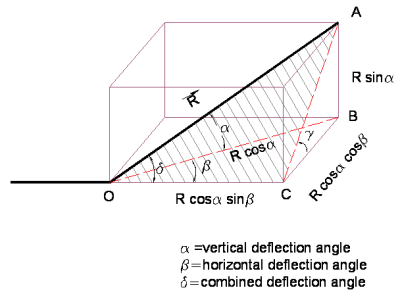
Abstract: Derivation of combined angle may become useful when you want to know the magnitude and direction of force due to bend in both XY and XZ plane. For eg in design of bend in pipeline.
Let us consider a straight line which deflects at O along OA as shown in the figure. The deflection angles are also shown in the figure.
Let R be the position vector of A. OB is projection of OA on XY plane and AB is projection of OA on a plane parallel to YZ plane. Similarly, OC is projection of line OB in X axis and BC is projection of OB on axis parallel to Y axis.
From figure it can inferred that
OB=R cosα
AB=R sinα
OC=OB cosβ = R cosα cosβ
BC= OB sinβ =R cosα sinβ
Therefore, the position vector of A is OA which is given by
R=|R| (cosα cosβ i + cosα sinβ j + sinα k )
And the unit vector along R is given by
r= (cosα cosβ i + cosα sinβ j + sinα k )
Now the combined deflection angle is given by
r . i =|r| |i| cosδ
Or, r . i =1*1 cosδ
Or, cosδ = cosα cosβ+0+0
Or, δ =cos-1(cosα cosβ)
The angle δ lies in the plane OAC. This plane is shown in the figure in hatch line.
Forces
If F be the magnitude of force due to the deflection δ (e.g. deflection in pipeline) then the vertical and horizontal component of this force is given by,
Fx1 =F r . i =F cosα cosβ
Fx2 =F r . j =F cosα sinβ
Fx =F
=F cosα
Fy =F r . j
=F sinα






Comments
that was good. It helped me a lot. Thanks dude.
I think your image is labelled incorrectly. OC and BC should be swapped. OC=R cosα cosβ and BC= R cosα sinβ, as you stated in your derivation.
Trackbacks
[…] simple analysis of combined angle (or compound angle) was described in this article.There the derivation was based on two deflection angles only. And hence the solution was […]